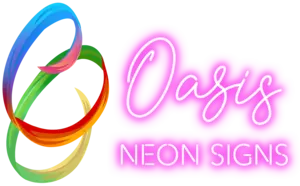
Neon vs Fluorescent: Key Differences
Share
Neon vs fluorescent lights have unique differences. They use glass tubing, but their inner components are different. Neon signs use inert gases to generate light. On the other hand, florescent tubes run via low-pressure argon gas and mercury vapor.
Apart from how these two lights work, there are other ways to differentiate them. We will explore these differences to ensure you understand each item before buying it. Keep on reading to comprehend what technologies these lights use and which one of them is better.
What is Neon Sign Lighting?

Neon vs fluorescent comparison will be easier if you understand the meaning of neon signs. Neon is an inert gas like Xenon, argon, helium, krypton, and radon. It has no color, taste, or smell and cannot explode. If you pass an electric current through neon, it will produce a red color. Neon consists of a tube filled with an inert gas like neon.
The glass tubing usually has metallic electrodes on each end. So, the electric current will ionize the neon gas to release electrons if you connect these electrodes to a strong electric current. The resulting electrons will travel through the gas while exciting its atoms.
These atoms will trigger a red light that will scatter via the glass tubing. Neon glass tube specialists can bend it into various shapes, allowing users to have a broad collection of products.
Unfortunately, the traditional neon signs using glass tubing are more delicate than the modern LED acrylic neon lights.
Glass neon tube lights are impossible to repair once broken, compelling you to handle them carefully. For the same reason, these lights are more expensive to buy and maintain than their modern LED counterparts. With LED neon signs, you can have a light that displays multiple colors. You get a dimming option to increase or reduce the intensity of the light.
If we consider the electricity consumption of neon signs, LEDs are more energy-efficient than traditional glass tube neon signs because of their LED bulbs. LED neon lights require only 12 volts to generate a bright glow, which occurs because of the LEDs. They can offer fifty thousand to one hundred thousand hours, passing as the most long-lasting options.
These sealed units are portable, low –maintenance, and easier to install because they are not as delicate as glass. Neon signs are ideal for business advertising because of their unrivaled radiance and beauty. These lights grab attention from afar, allowing an enterprise to get more customers.
What is Fluorescent lighting?

A fluorescent light is a long, thin tubing that releases a white glow. You often find fluorescent bulbs in classrooms, warehouses, hospital rooms, bank halls, stores, etc.
The traditional fluorescent is often called the compact fluorescent lamp (CFL). It is forty-eight to eighty-four inches long. These CFLs are compacted, which is why they are called “Compact.” CFLs could be several times better than incandescent bulbs because they are efficient and long-lasting.
No wonder they came as a replacement for the incandescent bulbs. A fluorescent light works virtually the same way as a neon sign. There is low-pressure mercury vapor and an inert gas like argon inside the tubing. The manufacturer inserts argon gas to prevent oxygen from corroding the tungsten filament in the glass tubing.
When you pass electricity through the fluorescent tubing, the mercury vapor generates a UV light. Since UV light can damage skin, the manufacturers of fluorescent tubes add a phosphor coat to the inner side of the tubing.
Phosphor is something that can absorb energy in a given form and emit it as a visible glow. In the case of fluorescent bulbs, phosphor coating receives the UV light from the mercury vapor and releases visible light photons.
Thus, the fluorescent tubing radiates light from the phosphor coating rather than the mercury or argon. Shorter fluorescent tubes consume less electricity to ignite while the longer ones need a lot of it to start.
Modern fluorescent light tubes are more advanced in technology. They do not blink repeatedly before producing a steady glow. The fluorescent lights have some demerits:
-
Contain Mercury – One of the most toxic substances that pollute the environment today is mercury. The phosphor coating on the inner side of the tubing is also poisonous.
-
Cannot Endure Constant Switching - If you turn CFLs on and off many times, they will eventually spoil. It is the case even though they can last 10,000hours.
Neon vs Fluorescent Lights – How to Differentiate Them
Now let us do our neon vs Fluorescent lights comparison. See how these two lighting products differ:
Distinct Technology Styles
Although neon and fluorescent lights use tubes, the light-generating components and technologies differ. Traditional neon signs use inert gases like argon, krypton, and neon to produce colored light. LED neon lights generate light via energy-saving light-emitting diodes.
On the other hand, fluorescent tubes contain low-pressure mercury that converts into UV radiation when an electric current passes through it. The phosphor coating then turns this UV radiation into a beautiful glow that we enjoy.
Applications
Another way to compare neon and fluorescent lights is by checking their applications. Neon sign lighting is uniquely used for advertising and decorations. Many people create neon signs that suit their business goals and needs. The dazzling neon signs attract passersby into the shop. A few neon signs are ideal for indoor use while others can withstand the harsh weather elements outside.
Whether you place them inside or outside your business, the neon signs’ main role is to advertise your products or services. The lights have uses in home and event venues decorations. For instance, you can use neon rope lights under your kitchen cabinet to enhance your vision during food preparations. Here are some inspiring design ideas of neon rope lights to brighten up any space and add a unique aesthetic touch.
Additionally, you can add a beautiful neon sign in your bedroom or living room to alter its mood. On the other hand, neon vs fluorescent differs in that the latter is an illuminating unit. You can use it only for illumination rather than decorating homes or commercial places. No wonder you find fluorescent lights in community places like schools and health centers.
Design
When checking the difference between neon and fluorescent lighting, you will notice a variance in their designs. The glass tubing neon signs come in all manner of twisted shapes regardless of the fact that glass is a fragile material. The same case applies to the modern LED neon signs that use bendable and flexible plastic materials.
No wonder LED neon signs are easy to customize. You can produce a unique design that suits your needs if you cannot find it in the pre-made collections online. When comparing neon vs fluorescent in this context, neon signs are more flexible. Fluorescent bulbs appear in horizontal tubes with similar shapes and varying lengths.
Longevity
Neon vs fluorescent tubes, which can last longer? If you need to answer this, here is what you should know. The lifespan of neon signs is generally longer. Unless you mishandle the glass tubes hosting inert gases, they will last longer even with minimal maintenance.
LED neon signs offer longevity more than traditional neon tubes and fluorescent bulbs. This is because they use LED technology that allows the lights to last between fifty and a hundred thousand hours. If you maintain them well, you can have your LED neon signs for years.
Conversely, fluorescent lights will only last about ten thousand hours. You will have to maintain them well and avoid switching them on and off repeatedly to consume all the 10,000 hours. These bulbs can keep on blinking and might wear down faster if you increase the switching.
Light Color
Do neon or fluorescent lights differ in terms of the color of the light they emit? The conventional glass tube neon signs emit the color of the gas they contain. For instance, the neon gas produces a red glow when energized while argon generates a violet or lavender blue glow.
A single neon sign can use different gases, thus producing a light of varying colors. LED neon emits a multicolored light. These lights create a spectacle wherever you install them.
On the contrary, fluorescent tubes produce the same white glow. It is the color of the phosphor coating that turns UV photons into a visible glow. It makes a good pick if the illumination color matters less to you than the light intensity.
Choose neon lighting as accent lighting to create a soothing mood in your room while adding to its beauty and style. Colored neon lighting is also an unrivaled advertising tool.
Conclusion
You can see which light is advanced when comparing neon vs fluorescent. Although each option has its advantages and disadvantages, the neon lighting technology seems superior. It may be so because you have two choices: traditional glass and LED acrylic tubes. You can buy LED neon lights if you do not want to deal with the delicate glass tubes with inert gases inside.
They are the most advanced options because of their modern technology. On the other hand, fluorescent lights of the CFL version are less advanced than LED neon signs. Do you need general lighting? If so, these bulbs will make perfect choices. You can alternatively use them with neon lighting if you need a decorative light.

